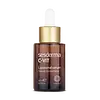What's inside
What's inside
 Key Ingredients
Key Ingredients

 Benefits
Benefits

 Concerns
Concerns

 Ingredients Side-by-side
Ingredients Side-by-side

Water
Skin ConditioningGlycerin
HumectantPropylene Glycol
HumectantPropanediol
SolventPolymethylsilsesquioxane
PEG-40 Hydrogenated Castor Oil
EmulsifyingGinkgo Biloba Leaf Extract
Skin ConditioningSodium Hyaluronate
HumectantResveratrol Dimethyl Ether
AntioxidantQuercetin
AntioxidantPalmitoyl Tripeptide-5
Skin ConditioningMorus Alba Root Extract
Bleaching3-O-Ethyl Ascorbic Acid
Skin ConditioningLecithin
EmollientAlcohol
AntimicrobialTocopheryl Acetate
AntioxidantAmmonium Acryloyldimethyltaurate/Vp Copolymer
Polysorbate 20
EmulsifyingXanthan Gum
EmulsifyingSodium Chloride
MaskingBHT
AntioxidantTriethanolamine
BufferingDisodium EDTA
Sodium Cholate
Skin ConditioningHydroxypropyl Cyclodextrin
MaskingRetinyl Palmitate
Skin ConditioningSodium Hydroxide
BufferingTocopherol
AntioxidantPhenoxyethanol
PreservativeEthylhexylglycerin
Skin ConditioningPotassium Sorbate
PreservativeParfum
MaskingCitronellyl Methylcrotonate
MaskingLimonene
PerfumingLinalool
PerfumingCitral
PerfumingCI 15985
Cosmetic ColorantWater, Glycerin, Propylene Glycol, Propanediol, Polymethylsilsesquioxane, PEG-40 Hydrogenated Castor Oil, Ginkgo Biloba Leaf Extract, Sodium Hyaluronate, Resveratrol Dimethyl Ether, Quercetin, Palmitoyl Tripeptide-5, Morus Alba Root Extract, 3-O-Ethyl Ascorbic Acid, Lecithin, Alcohol, Tocopheryl Acetate, Ammonium Acryloyldimethyltaurate/Vp Copolymer, Polysorbate 20, Xanthan Gum, Sodium Chloride, BHT, Triethanolamine, Disodium EDTA, Sodium Cholate, Hydroxypropyl Cyclodextrin, Retinyl Palmitate, Sodium Hydroxide, Tocopherol, Phenoxyethanol, Ethylhexylglycerin, Potassium Sorbate, Parfum, Citronellyl Methylcrotonate, Limonene, Linalool, Citral, CI 15985
Caprylic/Capric Triglyceride
MaskingGlycerin
HumectantButyrospermum Parkii Butter
Skin ConditioningButylene Glycol
HumectantCoco-Caprylate
EmollientHelianthus Annuus Seed Oil
EmollientSucrose Stearate
EmollientTrehalose
HumectantParfum
MaskingSucrose Distearate
EmollientArginine
MaskingSodium Hyaluronate
HumectantGlyceryl Caprylate
EmollientChondrus Crispus Extract
Skin ConditioningXanthan Gum
EmulsifyingLaminaria Ochroleuca Extract
Skin ConditioningAloe Barbadensis Leaf Juice
Skin ConditioningBiosaccharide Gum-2
Skin ConditioningPyrus Malus Seed Extract
Skin ConditioningCommiphora Mukul Resin Extract
Skin ConditioningAlaria Esculenta Extract
Skin ProtectingCitric Acid
BufferingPhytic Acid
Brassica Oleracea Italica Extract
AstringentCamellia Sinensis Leaf Extract
AntimicrobialSilybum Marianum Extract
Skin ConditioningCaprylic/Capric Triglyceride, Glycerin, Butyrospermum Parkii Butter, Butylene Glycol, Coco-Caprylate, Helianthus Annuus Seed Oil, Sucrose Stearate, Trehalose, Parfum, Sucrose Distearate, Arginine, Sodium Hyaluronate, Glyceryl Caprylate, Chondrus Crispus Extract, Xanthan Gum, Laminaria Ochroleuca Extract, Aloe Barbadensis Leaf Juice, Biosaccharide Gum-2, Pyrus Malus Seed Extract, Commiphora Mukul Resin Extract, Alaria Esculenta Extract, Citric Acid, Phytic Acid, Brassica Oleracea Italica Extract, Camellia Sinensis Leaf Extract, Silybum Marianum Extract
Ingredients Explained
These ingredients are found in both products.
Ingredients higher up in an ingredient list are typically present in a larger amount.
Glycerin is already naturally found in your skin. It helps moisturize and protect your skin.
A study from 2016 found glycerin to be more effective as a humectant than AHAs and hyaluronic acid.
As a humectant, it helps the skin stay hydrated by pulling moisture to your skin. The low molecular weight of glycerin allows it to pull moisture into the deeper layers of your skin.
Hydrated skin improves your skin barrier; Your skin barrier helps protect against irritants and bacteria.
Glycerin has also been found to have antimicrobial and antiviral properties. Due to these properties, glycerin is often used in wound and burn treatments.
In cosmetics, glycerin is usually derived from plants such as soybean or palm. However, it can also be sourced from animals, such as tallow or animal fat.
This ingredient is organic, colorless, odorless, and non-toxic.
Glycerin is the name for this ingredient in American English. British English uses Glycerol/Glycerine.
Learn more about GlycerinParfum is a catch-all term for an ingredient or more that is used to give a scent to products.
Also called "fragrance", this ingredient can be a blend of hundreds of chemicals or plant oils. This means every product with "fragrance" or "parfum" in the ingredients list is a different mixture.
For instance, Habanolide is a proprietary trade name for a specific aroma chemical. When used as a fragrance ingredient in cosmetics, most aroma chemicals fall under the broad labeling category of “FRAGRANCE” or “PARFUM” according to EU and US regulations.
The term 'parfum' or 'fragrance' is not regulated in many countries. In many cases, it is up to the brand to define this term.
For instance, many brands choose to label themselves as "fragrance-free" because they are not using synthetic fragrances. However, their products may still contain ingredients such as essential oils that are considered a fragrance by INCI standards.
One example is Calendula flower extract. Calendula is an essential oil that still imparts a scent or 'fragrance'.
Depending on the blend, the ingredients in the mixture can cause allergies and sensitivities on the skin. Some ingredients that are known EU allergens include linalool and citronellol.
Parfum can also be used to mask or cover an unpleasant scent.
The bottom line is: not all fragrances/parfum/ingredients are created equally. If you are worried about fragrances, we recommend taking a closer look at an ingredient. And of course, we always recommend speaking with a professional.
Learn more about ParfumSodium Hyaluronate is hyaluronic acid's salt form. It is commonly derived from the sodium salt of hyaluronic acid.
Like hyaluronic acid, it is great at holding water and acts as a humectant. This makes it a great skin hydrating ingredient.
Sodium Hyaluronate is naturally occurring in our bodies and is mostly found in eye fluid and joints.
These are some other common types of Hyaluronic Acid:
Learn more about Sodium HyaluronateXanthan gum is used as a stabilizer and thickener within cosmetic products. It helps give products a sticky, thick feeling - preventing them from being too runny.
On the technical side of things, xanthan gum is a polysaccharide - a combination consisting of multiple sugar molecules bonded together.
Xanthan gum is a pretty common and great ingredient. It is a natural, non-toxic, non-irritating ingredient that is also commonly used in food products.
Learn more about Xanthan Gum